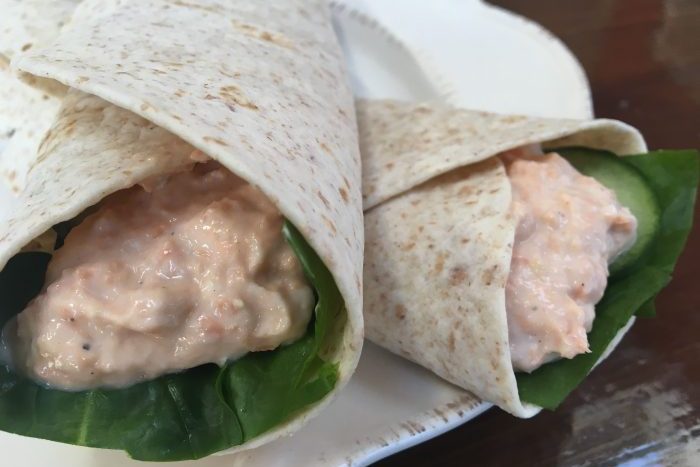A healthy and tasty lunchbox option; simple enough for children to make for themselves.
Tinned salmon is a good budget option for increasing your oily fish intake. Scientists recommend eating at least 2 portions of fish each week; one of which should be oily fish.
Skills Check
Follow a recipe; follow food safety & hygiene rules; tidy away; use measuring spoons and cups; cut using bridge/claw technique safely; use a tin opener safely; use a colander; use a citrus squeezer; season to taste.
Equipment
Tin opener, colander or sieve, medium bowl, measuring spoons, citrus squeezer (optional), spoon, chopping board, knife.
Allergens (Please note the allergens listed are indicative only. Allergens vary depending on brand; check the labels on the products you use.)
Gluten | Mustard | Eggs | Milk | Fish
Ingredients (serves 2):
- 60 g tin of pink salmon
- 1 tbsp reduced fat mayonnaise
- 1 handful of baby spinach leaves
- 1/4 cucumber, sliced
- Juice of 1/2 lemon
- Black pepper, to taste
- 2 wholemeal wraps
Method
- Drain the liquid from the tin of salmon and place in a bowl.
- Add the mayonnaise, black pepper and lemon juice.
- Mix well to combine all the ingredients.
- Layer the baby spinach leaves and cucumber along the middle of the two wraps, and spoon half the salmon mixture on top of each one.
- Fold the bottom of the wrap upwards and then fold and roll the wrap to secure the filling.
So thinking about salmon and spinach wraps ...

Wheat wraps, like bread, are a good source of complex carbohydrates which gives us energy. Generally wholemeal breads/wraps tend to be more nutritious than white, and they also contain more fibre.
Nutritional Information
| Energy | 1247kJ/297kcal | 15% | |
| Med | Fat | 12.0g | 17% |
| Low | Saturates | 2.2g | 11% |
| Low | Sugars | 3.3g | 4% |
| Med | Salt | 1.5g | 25% |
per 191g serving
% of an adult's reference intake
Typical values per 100g: Energy 653kJ / 156kcal
Notes
A traffic light system is used on nutrition labels to make it easier to see which foods and drinks are lower in calories, fat, sugar and salt. Try and choose more ‘greens’ and ‘ambers’ and fewer ‘reds’, and stick to smaller portions of ‘reds’.
Just because a recipe or a food has a red traffic light doesn’t mean you shouldn’t eat it. Understanding why a food or recipe might have a red light can be helpful. For example oily fish is high in total fat and so any recipe containing oily fish is likely to be ‘red’ for fat. But it is recommended that we eat oily fish at least once a week because the type of fat it contains is beneficial for our health.
% Reference Intakes are also shown. Reference Intakes are guidelines about the approximate amount of particular nutrients and energy required for a healthy diet (based on an average-sized woman doing an average amount of physical activity). Most children will require less than these Reference Intakes. The contribution of one serving of a food or drink to the Reference Intake for each nutrient is expressed as a percentage.




